
views
- Create a base for the rock out of styrofoam, cardboard, or plywood. Cut the base down to the size and shape of your rock, then cover it in a mortar mix.
- Give your rock texture with a sponge or a trowel. Add gray or brown acrylic paint to make your rock look realistic.
- Use your fake rocks in your landscaping outside. Dig a small hole for the rocks to sit in to make them look more natural.
Building a Form
Choose a material as a base for your rock's shape. You can use a variety of materials to create the shape of your rock. There are several common items you can choose from: Styrofoam Cardboard Crumpled newspaper Plywood Expanding foam
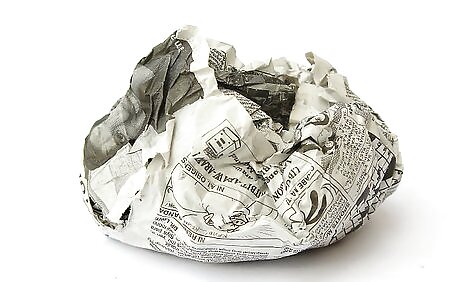
Cut the base into the rough shape of your rock. Use a handsaw or a jigsaw to cut your material into the rough shape of your rock. Remember, most rocks are not completely smooth, so give your shape textures and dimples as you cut. A hot wire foam cutter works well to shape styrofoam. If you’re using plywood or cardboard, cut small squares and then stack them on top of each other to create a rock shape. Then, use a saw to cut off the hard edges and smooth them out. To make a rock out of expanding foam, spray the foam into a circular pile, then wait for it to harden. Use a saw to shave down the sides and smooth the foam into a rock shape.

Cover your rock shape in chicken wire or hardware cloth. Use a metal mesh to wrap the rock shape. The metal gives strength to your artificial rock and provides a structure for the cement mortar mix to adhere to. Use wire twist ties to secure the wire frame to your rock base.

Refine the curves of your rock. To make the most natural looking rock, bend and shape the wire form around your rock shape. Natural rocks have dips and creases; simulate these shapes by pushing your wire form in various places to create uneven surfaces.
Mixing the Mortar
Combine dry ingredients for mortar mix. Mix 3 parts sand with 1 part portland cement. Add all the ingredients to a wheelbarrow or concrete mixer, depending on the size of rock you are creating and amount of mortar you are mixing. You can reduce the sand, and add 1 part peat moss to create a more porous artificial rock. If you want to use the fake rocks in an area exposed to water, use a hydraulic cement mix instead.
Mix the dry mortar and sand mixture into 1 part of cold water. The exact amount of water depends on humidity and temperature conditions, so you may need to adjust with more or less dry mixture. Slowly add the dry mixture to the water while mixing with a trowel until both form into a thick paste. Stir the mortar mix into the water as you add it. Watch closely as you add mortar so your mixture does not get too thick. Aim for a cookie dough-like consistency.
Stir the mortar mix for several minutes. For small amounts, turn the mixture over in the wheelbarrow repeatedly, or stir with a paddle attached to an electric drill. For larger amounts, use a concrete mixer. Mix the mortar to the consistency of cookie dough. Ensure the mixture is fully mixed and uniformly wet. Add more water if necessary to get the consistency of a thick paste. You do not want the mixture to be runny. Unmixed blobs of sand will cause weak spots in the finished rock; be sure to mix everything completely.
Sculpting the Rock
Apply the mortar mix to the wire form with a trowel. Use a flat pointed trowel to apply a 2 to 3 in (5.1 to 7.6 cm) layer of mortar to the wire frame. Start from the top of the rock and slowly push the mortar mix down the sides. You can also use your hands to push and spread the mortar mix around. Just be sure to wear rubber gloves to protect your skin. You can cover the bottom of the rock with mortar mix, or you can leave it as-is. If your rock is going to be sitting on the ground, don’t worry about spreading the mixture to the very bottom.
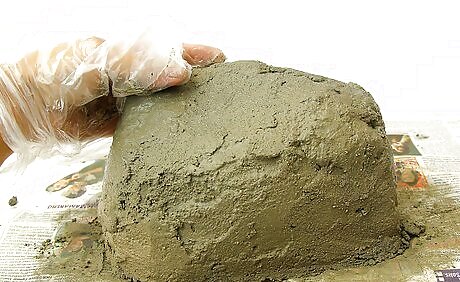
Add texture to the mortar with a sponge or brush. Create a realistic looking rock by adding contours and patterns to the surface of the mortar. Gently stipple a sponge or a paint brush into the mortar mix while it’s still wet to give it a more realistic look. Use your trowel to create dips and creases in the surface of the mortar. Press a real rock into the mortar to make imprints of the rock's texture. Press a sea sponge or scouring pad into the rock to create a pock marked look. Wrap a plastic bag around your hand and press it into the mortar to give a wrinkled look.
Cure the rock for 3 to 5 days in a dry location. Keep your “rock” in a clean, dry spot out of direct sunlight, and leave it for a couple of days. The concrete will cure and harden until your rock looks dry. Although 75% of the curing is completed after 1 week, it may take up to a month for cement to cure completely. However, the outside of the rock will be dry after 3 to 5 days.
Finishing the Rock and Landscaping
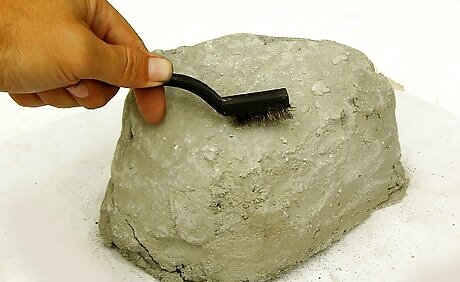
Scrape the rock to smooth the edges. Once the rock has cured, you can add any finishing touches you’d like. Smooth out rough edges with a wire brush or a sanding sponge to make your rock look more realistic. Make sure the outside of the rock is fully dry before you try brushing it. Otherwise, it could crumble.
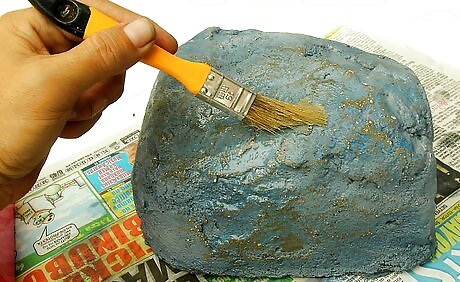
Paint the rock shades of gray and brown. When you look at your rock, you might notice that it looks a little too gray to be believable. Use some gray acrylic paint and brown acrylic paint in the crevices of the rock if you’d like to. Painting is totally optional, but many people find that it makes large rocks look more realistic. Access clear DIY instructions for free. "I saw a neat show where they crafted these incredibly realistic fake boulders. I desperately wanted to try making my own, but getting my hands on the fancy instructional stuff was way out of my budget. Luckily, these free step-by-step directions with pictures walked me through the entire process, from choosing materials to mixing convincing textures. Now, this inspiring new hobby is accessible for my wallet!" - Joerg F. Gain knowledge to undertake an exciting new hobby. "I was so impressed when I saw artificial rocks being made on TV. But as a total beginner, I had no clue how to pull something like that off myself. This guide explained things so clearly — how to shape foam bases, blend mortar mixes, and even paint for added realism. Now I feel completely prepped to try this creative skill that dazzled me onscreen!" - Elaine R. Expand expertise in a beloved craft. "As a huge faux stone fan, I'm always trying to improve my boulder-crafting abilities. The finishing touches here, like color-matching landscapes, and contouring placement pits, really leveled up my skillset. I can't wait to apply those details to make my decorative rocks indistinguishable from the real deal!" - Leslie G. Save money fixing the previous owner's mistake. "The former owner of our new place built this gorgeous faux brownstone wall that, unfortunately, let rainwash erosion happen. As much as we adored the craftsmanship, retaining wall rebuilds add up fast. But these budget tips let us seamlessly blend inexpensive matching rocks into the existing barrier. Our wallet and the hillside look beautiful now!" - William W. Have a story our readers should hear? Share it with 1 billion+ annual wikiHow users. Tell us your story here.
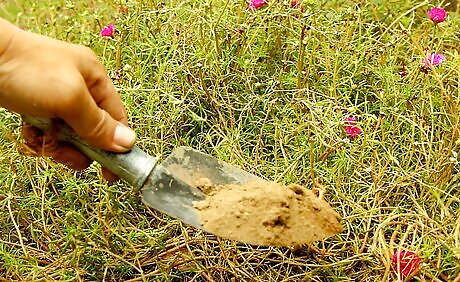
Dig a small indention where the rock will be placed. Place the rock in place and trace the edge of the rock with a stick or shovel. Dig a 1 to 2 in (2.5 to 5.1 cm) pit in the shape of the rock. Placing the edges of the rock underground will provide a more natural look of a rock outcropping. Use small rocks to create a pathway or line a firepit. Use bigger rocks to cover up septic tank hatches or electrical boxes.
Place the rock in the hole. Push dirt and other small rocks against the edge of the rock to integrate it with the landscape. Build multiple rocks to create elaborate rock landscapes. Have fun landscaping with your DIY rocks!















Comments
0 comment